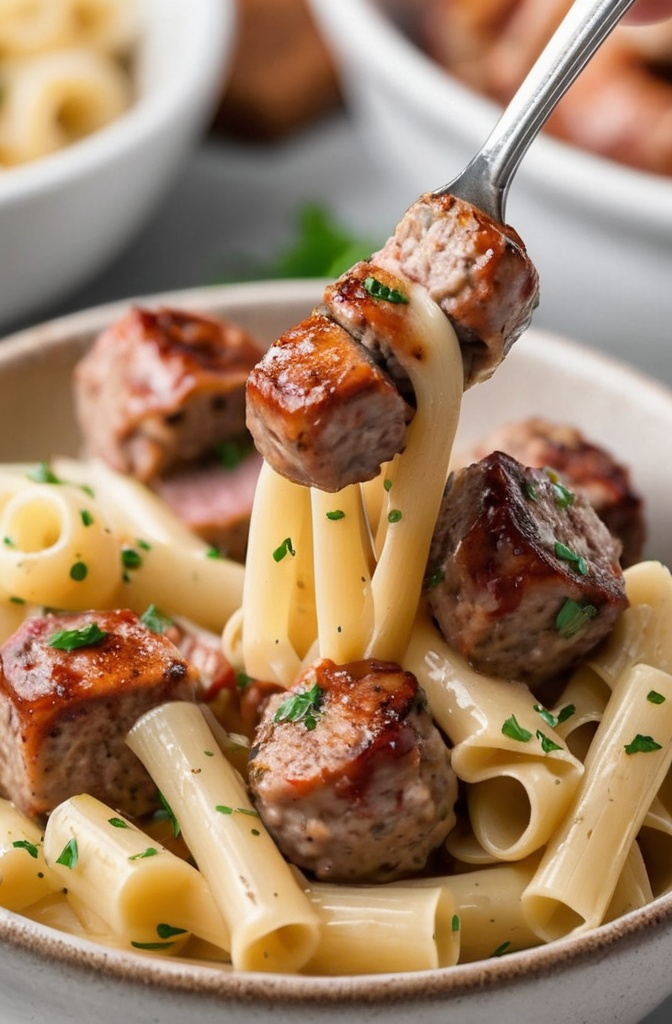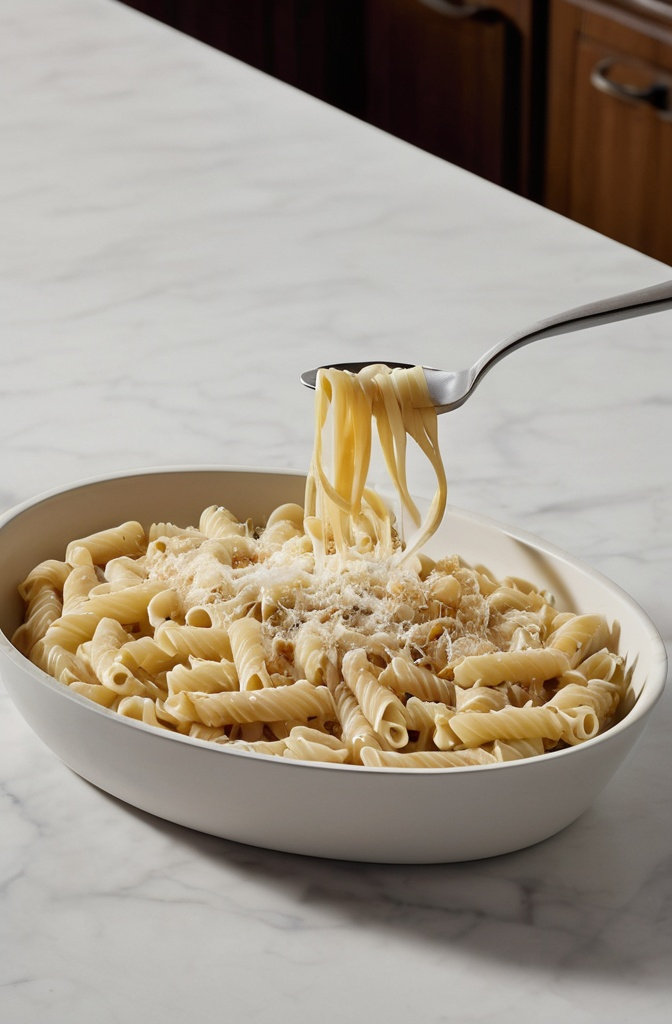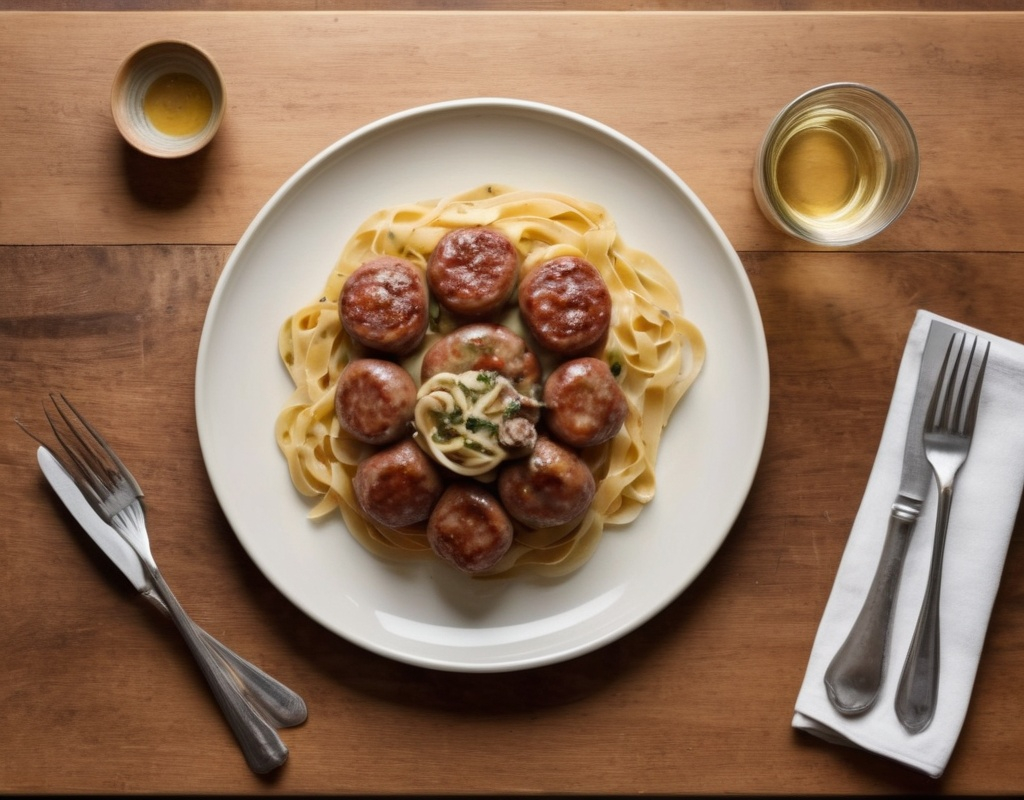Sausage doesn’t wait for your permission. It hits the pan running. It owns its space. When you marry that kind of attitude with garlic butter—honest-to-goodness browned butter, sticky with caramelized garlic—and give it a bed of al dente parmesan pasta, something primal clicks. You’re not just feeding people. You’re waking them up.
This article dives deep. We’re breaking down how to build the perfect garlic butter sausage bites, how to anchor them with a deeply savory parmesan pasta, and why the dish works so well at the molecular and psychological level. Yeah, we’re going there. Chefs, line cooks, culinary directors—this one’s for you.
This is not another weeknight Pinterest hack. This is craft. It’s about discipline, ratios, control of heat. But above all, it’s about gutsy flavor that doesn’t beg to be liked. It just is.
Why This Dish Works (and Wins)
At the core of every great dish is contrast. Soft and sharp. Rich and clean. The sausage brings brute umami—fat, salt, spices. The garlic butter adds depth, rounding sharp edges with mellow warmth. And the parmesan pasta? It’s your foundation. Salty, creamy, starchy. Think of it as the straight man in the act—quiet, but without it the whole thing falls apart.
Fat is flavor, sure, but too much and you get mud. That’s why timing and technique are king here. Render the sausage too hot and you get scorched oil. Not enough garlic and the butter doesn’t sing—it just slogs.
And it’s not just about taste. There’s science here too. The Maillard reaction—your best mate in flavor development—needs dry heat and high temps. So when that sausage hits the pan, don’t crowd it. Don’t even talk to it. Let it sear. Let it earn its crust.
Building Blocks: The Sausage
Not all sausages are born equal. And no, your average supermarket hot link won’t cut it.
Go for coarsely ground pork sausage with visible flecks of fat. You want about 75/25 lean-to-fat. That fat’s gonna render into the pan, forming the base of your garlic butter. You want that richness, not grease.
Avoid pre-cooked sausages. They’re fine for picnics, not for professional kitchens. Fresh, raw sausage gives you full control of texture and flavor infusion.
Expert Tip: If you’re working in a high-volume kitchen, semi-freeze the sausage before slicing into bite-sized coins. It helps with clean cuts and faster sear.
Flavor Note: Fennel-forward Italian sausages work beautifully here. So does Cajun for a spicier twist. Even Spanish chorizo—though you’ll need to balance that smoky paprika with some lemon zest in the butter later.

Garlic Butter: No Shortcuts, No Mercy
Garlic butter isn’t just garlic and butter. If you’re doing that, stop now. What you want is layered depth.
Start with whole garlic cloves. Smash them. Don’t mince. Mincing burns fast and ruins the sweetness. Brown the garlic slowly in a mix of butter and a touch of neutral oil (grapeseed is fine). The oil raises the smoke point. Once golden, pull the garlic out. You’ll add it back later.
Now reduce the heat. Add in a touch of white wine—dry, nothing sweet. Deglaze the pan from the sausage, pull up all that fond. Then swirl in cold butter, off heat. Emulsify. Finish with the garlic. Maybe a splash of lemon. Maybe a pinch of chili flakes.
If your butter breaks, it’s not ruined. It’s rustic. Pretend you meant it. Just don’t serve it separated without knowing how to own the choice.
Parmesan Pasta: More Than a Sidekick
This isn’t mac and cheese with better PR. Parmesan pasta done right is silky, salty, and built on emulsion science.
Start with spaghetti or bucatini. Cook it in just enough salted water—too much and you lose the starch. You want that cloudy water. That’s your sauce binder. Keep at least a cup of it before draining.
In a separate pan, melt butter (yes, more butter) and add a small ladle of that starchy pasta water. Stir in heaps of finely grated Parmigiano-Reggiano. Not pre-shredded. Not parmesan “style.” The real stuff.
Toss the hot pasta into the sauce and move fast. Toss like it owes you money. The motion emulsifies the cheese and fat with the starch, coating each strand. Add a crack of pepper. Maybe a drizzle of that garlic butter you made earlier.
Real World Trick: In restaurant service, we sometimes finish the pasta in the same pan as the sausage bites. It saves a pan, but more importantly, it marries the flavors. Just watch the salt levels—parmesan and sausage both bring plenty.
Plating for Impact
Here’s where so many drop the ball. They plate like they’re apologizing. Don’t. Build height. Contrast color. Make it look like it tastes.
Tangle the pasta in a small nest. Place the garlic butter sausage bites around, not dumped on top. Spoon over a touch of garlic butter. Shave fresh parmesan. Hit it with herbs—chopped parsley or even fried sage. A final crack of black pepper. Done.
And please, no dried parsley. That’s not garnish. That’s regret.
Common Pitfalls (And How to Dodge Them)
1. Overcooked Sausage
Rubbery. Dry. Sad. Avoid this by searing fast and hot, then pulling them out before they’re fully done. They’ll finish cooking when tossed back in the garlic butter.
2. Broken Garlic Butter Sauce
Too much heat. Not enough motion. Keep butter additions cold and stir constantly off heat.
3. Clumpy Parmesan Pasta
Wrong cheese or cold pasta. Use finely grated Parmigiano-Reggiano, and toss it hot with starchy water. No shortcuts.
4. Greasy Finish
Balance fat with acid. Lemon juice, white wine, or a vinegar-based chili oil can lift the dish.

A Bit of Data for the Nerds
- Parmesan cheese contains up to 33% protein and 28% fat. That means it melts creamy but also browns well, making it ideal for finishing pastas.
- Garlic’s flavor compounds (like allicin) are released when crushed and change with heat exposure. Raw garlic = sharp. Roasted garlic = sweet. Browned garlic = nutty, complex.
- The average sausage bite, depending on size and meat content, holds around 80-100 calories. That’s fat-dense energy—ideal for high-intensity service environments or recovery meals.
Food cost note: The combined dish sits at about 20-25% food cost for most restaurant margins, assuming moderate bulk purchase. You can elevate it with artisan sausage or heirloom garlic, but the base is efficient and scalable.
Emerging Trends: Where It’s Headed
Chefs are now playing with global twists on the classic. Think miso-garlic butter sausage over soba noodles. Or Andouille with browned Cajun butter and manchego pasta. There’s also a move toward smoked fats—using smoked butter or finishing oils for added depth.
In upscale bistros, you’ll see house-fermented garlic pastes or black garlic used in the butter. Others are cutting in anchovy oil or using bone marrow fat instead of butter. If it sounds intense—it is. But it works.
Vegan versions? Yep. Plant-based sausage has come a long way. Look for high-protein versions that crisp like the real thing. Use olive oil and roasted garlic puree for the butter effect. Vegan parmesan alternatives still lag behind in melting performance, but a little nutritional yeast and cashew cream can carry you close.
Final Word: Let the Dish Speak
Garlic butter sausage bites with parmesan pasta isn’t subtle. It’s not demure. It doesn’t whisper flavor—it belts it out like it’s got something to prove. And it delivers. Every bite’s a layered statement. Rich, bold, a little cheeky.
Professionals who cook this right—who respect heat, fat, acid, and timing—will find a dish that fits anywhere: small plates menus, after-service staff meals, even high-end takeout.
Just remember: sausage don’t lie. You burn it, you wear it.
Now go cook. Make it unapologetic. Make it loud.
FAQs
What type of sausage works best for this recipe?
Use coarsely ground, raw pork sausage with visible fat—preferably Italian or Cajun style.
Can I use pre-cooked sausage?
Nope, it won’t sear properly or release flavorful fat for the garlic butter.
How do I stop garlic butter from breaking?
Add cold butter off heat and stir constantly to emulsify.
Why smash garlic instead of mincing?
Smashing releases flavor without burning fast like minced garlic does.
What’s the ideal pasta for parmesan sauce?
Use spaghetti or bucatini for their structure and starch release.
Can I use pre-grated parmesan?
No, it doesn’t melt well—always use freshly grated Parmigiano-Reggiano.
Why is pasta water important?
It’s loaded with starch that helps emulsify the sauce and coat the pasta.
How do I keep sausage bites juicy?
Sear hot and fast, then finish cooking gently in the garlic butter.
Can this dish be made vegetarian or vegan?
Yes—with plant-based sausage, roasted garlic oil, and vegan cheese alternatives.
What herbs work best as garnish?
Fresh chopped parsley, fried sage, or a hint of thyme all play well.
What’s the food cost for restaurants?
Around 20–25% depending on quality of sausage and cheese used.
How do I prevent greasy finish in the dish?
Balance the fat with acidity—add lemon juice or dry white wine.
Is this dish scalable for high-volume service?
Absolutely, just prep the components and finish fresh per order.

Mariana is a passionate home cook who creates delicious, easy-to-follow recipes for busy people. From energizing breakfasts to satisfying dinners and indulgent desserts, her dishes are designed to fuel both your body and hustle.
When she’s not in the kitchen, she’s exploring new flavors and dreaming up her next recipe to share with the Foodie Hustle community.

